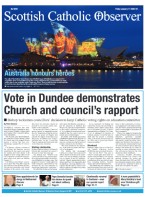November 8 | ![]() 0 COMMENTS
0 COMMENTS ![]() print
print

When it comes to the Faith of our fathers, Carndonagh has the hedge
The courage our forebears in Ireland’s heartlands can still teach a lesson or two, writes Hugh Dougherty.
If you’re ever in Inishowen in County Donegal, make sure you visit Carndonagh, situated close to the northerly tip of the peninsula, close to Ireland’s northernmost point at Malin Head.
Carndonagh is near where my family is from and boasts three religious sites within touching distance, summing up the history of the Faith in Ireland.
Best known is St Patrick’s Cross, also called the Carndonagh Cross, which dates from the 7th century, and was close to a long-lost monastery founded by the saint himself, who died some 200 years before the cross was erected. The cross is sculpted from stone, and is where priests would have preached the Gospel. It’s remarkable for its carved symbols, representing the Crucifixion and the tree of life. Side slabs show King David with his harp and also a pilgrim with staff and bell, showing that this cross was a powerful symbol of the Christian Faith.
It’s not stretching the imagination to picture my ancestors listening to the Gospel there, at the foot of the Carndonagh Cross, and there’s a powerful sense of the past surrounding the monument which lies on the Ballyliffin Road out of the market town, protected by a wooden canopy.
The cross is a survivor from the great age of Christianity in Ireland, when monks wrote and illustrated the great books of the Gospel, such as the Book of Durrow, whose decoration mirrors the carvings at Carndonagh, when monasteries abounded, and when saints and scholars took the Christian religion from Ireland, teaching and converting throughout Europe.
Persecution
But, come the invading English and Scots, especially after the Plantation of Ulster in the early 17th century, Irish Catholics found themselves in a very different position. Under the cosh of draconian penal laws preventing them from attending Mass, owning property, holding public office or in anyway practising their Faith.
Close by the 7th century Cross, you’ll find a survivor from the darkest days of those times, in the shape of Mass Rock, where faithful Catholics risked life and limb to hear the Word of God, and to receive Holy Communion.
Brave priests and congregations assembled here, hidden away from the road by trees, or, in other places, situated high on mountainsides or in the vastness of the bogs, so that soldiers couldn’t find them.
Lookouts were posted around the Mass Rock, where the Blessed Sacrament would be celebrated.
Risking lives
It’s a sobering thought, in our 21st century, when getting to Mass has never been easier, that so many are turning their backs on attendance, not just in Ireland, but here, too, that, in penal days, people would risk their lives to be there.
I can imagine my ancestors at that rock, determined to pass on their beliefs to the next generation, which they clearly did with great success. That’s why I always remind my own children of the brave and dearly won, and kept, Irish Catholic heritage to which they are heirs. If their forebears were ready to risk life and limb for their Faith, then it is surely worth keeping and fighting for today.
The Carndonagh Mass Rock is hidden away in a grove, and it’s easy to imagine the faithful crowded round the altar as the priest celebrated Mass, hidden away, and seeking safety from persecution, with the children being taught by brave ‘hedge school’ teachers, as schooling of Catholics was also forbidden.
But, take yourself out, along the path to the main road again, and within sight of the Carndonagh Cross, you’ll see a symbol of Catholicism from a rather different era in Church history.
Sacred Heart
It’s the massive Church of the Sacred Heart, built in 1942, to dominate the town, and, some say, to reflect the might, power and influence of the Catholic Church in Eamonn De Valera’s Ireland, then at its height.
Costing £60,000, a fair sum for those days, the church is one of very few completed in Europe during World War II, and its size and importance, with its Italianate bell tower, speaks of an era, of confident Irish Catholicism, with penal times a distant memory.
We used to attend Sunday Mass as a family there some 30 or so years ago when our boys were small and we were on holiday in Inishowen, and, today, if stopping in Carndonagh, we always include the church in our ‘pilgrimage’ round the historic, religious sites.
Like everywhere else in Ireland, the congregation is smaller than 30 years ago, but, as with all churches in
Donegal, the county which, alone, voted against abortion in the recent referendum, it’s still far in excess of the secular heartlands of Ireland, such as Dublin, where Mass attendance has slumped to around 10 per cent.
Secular age
That’s Carndonagh, then, a town rich in Catholic heritage, and a place which reminds me that my ancestors, whose Faith stretched back to the time of St Columba, have passed on something very precious to me and my own family over the centuries.
We all need to connect with our Catholic heritage, for it’s sobering to remember that we are but a link in a chain stretching back through the centuries. We have no right to drop our link in that chain, especially in this secular age—the new penal times.










